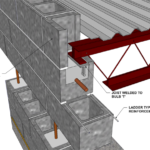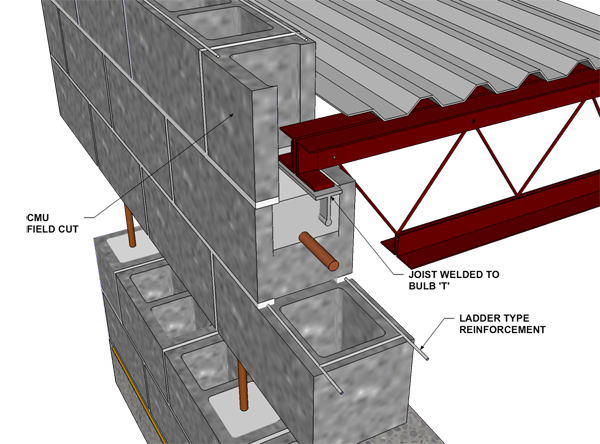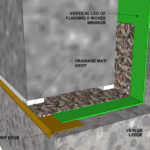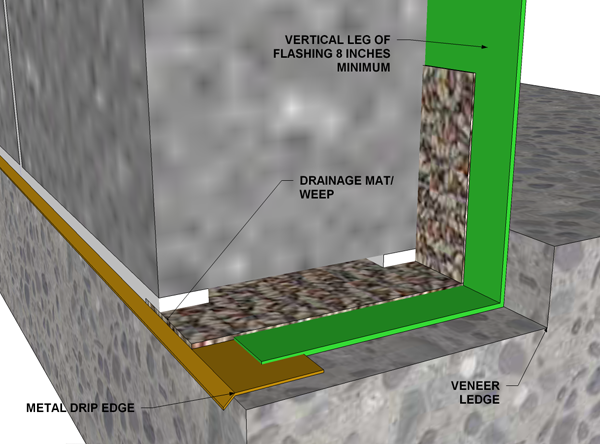Reinforced Concrete Block
This efficient and economical masonry system allows a single layer of concrete block to serve as the structure and the exposed surface of the wall.
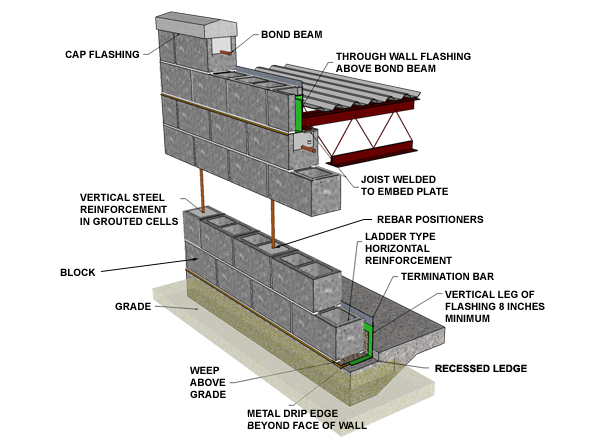
Back
Recommended Building Types
- Warehouses, industrial buildings
- Interior partition walls
- Choosing the Right Masonry System for your Budget
- Guidelines for Single Wythe Walls
Benefits
- Single wall layer provides the structure, exterior surface finish, and (in some designs) interior surface finish
- Most economical wall type
- Durable, inherently fire-proof with fire ratings up to 4 hours
- Excellent choice for interior partitions where noise abatement, fire separation, and durability are important: offices, schools, hotels
Special Considerations
- No drainage cavity – can be difficult to make weather-tight without coating the exterior wall face.
- Do not use batt insulation behind a single-wythe wall. Water may leak through the wall, and wet batts have little or no insulating value. Use rigid insulation board that can tolerate occasional moisture.
- Exercise caution when using this wall system in climates with above average precipitation.
Definition and Assumptions
Units: Lightweight plain gray concrete block (CMU), 8″ x 8″ x 16″(nom.)
Reinforcement: #6 vertical reinforcement at 32″ on center 9-gauge joint reinforcement at 16″ o.c. (every other course)
Flashing: Base Flashing and weeps
Mortar: Type N, Portland cement/lime, plain gray
Joints: Concave tooled
Regional Variations
- Designers in the Pacific northwest have learned how to use single-wythe concrete masonry walls effectively for shopping centers, restaurants, hotels, schools, fire and police stations. In these applications, an opaque elastomeric coating is used to form a weather barrier on the outside wall face. (See Masonry & Ceramic Tile Institute of Oregon: www.mioctio.org)
- Many areas of the western U.S. have good local sources for lightweight aggregate, and the use of lightweight concrete block (CMU) is the norm. In other parts of the country, medium weight and normal weight block are more common.
- Structural masonry walls in areas of high seismic risk are required to have additional horizontal bond beams to resist seismic loads. Check with your structural engineer to determine what is required in your region.
- The use of reinforced bond beams can replace the necessity for joint reinforcement in concrete masonry walls. Understand that some form of horizontal reinforcement is required in all concrete masonry construction, including veneer applications.
- Type S Mortar is required for areas of high seismic risk: check with your structural engineer to determine what is required for your region.
Fire Rating (hours)
Ungrouted CMU: 2 hrs
Grouted at 32″ on center: 3 hrs
Fully grouted CMU: 4 hrs
Sound Transmission Class (dB)
Ungrouted: 46.2
Grouted 32″: 49.5
Fully grouted: 56.3
STC=(weight of wall)0.223x21.5
Wall Weight (lb/sq. ft.)
Ungrouted: 31 lb/sq. ft
Grouted 32″: 42 lb/sq. ft
Fully grouted: 75 lb/sq. ft
Energy Rating
R-value: 2.3 (see note)
Calculation:
| Outside Air | =0.17 |
| 8 inch CMU 105 pcf, grouted at 32″ o.c. | =1.45 |
| Interior Air | =0.68 |
| Total | =2.3 |
- R-Value/U-Factor Calculator (configurable)
- R-Values of Single-Wythe Concrete Masonry Walls
- Introduction to Energy Performance of Brick Masonry
Note: Adding insulation to the ungrouted cells raises the R-value from 2.3 to 4.65. If you need a greater R-value, add furring and rigid insulation to the inside face of the wall.
Sustainability & LEED
- Energy efficiency, thermal comfort and energy analysis – up to 10 pts
- Innovation and design – 1 pt
- Recycled content – 2 pts
- Regional material (where applicable) – 2 pts
- Renewable energy and thermal mass – up to 10 pts
- Concrete Masonry and the LEED Program
- Determining the Recycled Content of Concrete Masonry Products
Design Tips
- Add a layer of rigid insulation at the interior wall face as a moisture barrier and to provide additional R value. Use Flashing and weep holes where required.
- Careful attention to moisture management is necessary.
To make walls more weather resistant, consider the following:
- Maximum resistance to rain penetration is achieved when an opaque, elastomeric coating is used. In wet climates, lightweight units should not be exposed to weather but should be treated with opaque coating.
- Medium weight units that are manufactured with integral water repellents perform best in creating a moisture resistant system. This system must also include a water repellent admixture used in the Mortar as well as a high grade, deep penetrating, breathable water repellent applied to the exterior surface of the wall.
- Avoid using highly permeable units, such as split face, ground face, and lightweight units that use pumice aggregate. These block types are very difficult to protect with spray-applied water repellents. An opaque elastomeric coating can be used to weatherproof these types of units.
- Use white Portland cement or marble chips to achieve color variations rather than pumice, which is very porous and absorptive.
- Include good sills and good wall caps to minimize moisture infiltration.
- Remember to design weeps and weeps at the base of walls, over openings, bond beams, and other features that might tend to collect water within the wall. In high seismic areas where the walls are reinforced and grouted, the use of internal wall Flashing is impractical.
- Or, consider fully grouting all cells to make a barrier wall system.
- Be sure to include regular expansion joints and horizontal joint reinforcement to minimize shrinkage cracks.
- Mortar diverter products, placed in bed joints above Flashing, can help to keep Mortar droppings off Flashing.
Construction Tips
- Do not clean walls with sandblasting methods, which tend to open the pore structure at the block face.
- Use full face-shell bedding and Mortar with a high water retention to avoid shrinkage cracking at Mortar joints.
